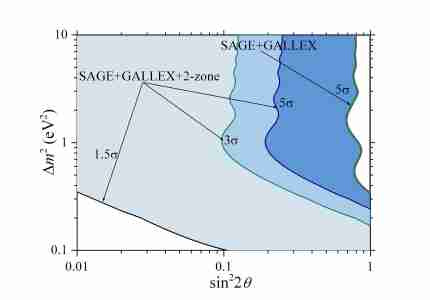Poster Summaries Part I: Status of the Baksan experiment with a Dual Metallic Ga Target and a 51Cr Neutrino Source
Status of the Baksan experiment with a Dual Metallic Ga Target
and a 51Cr Neutrino Source
B. T. Cleveland, S. R. Elliott, V. N. Gavrin, V. V. Gorbachev, T. V. Ibragimova, V. A. Matveev, I. N. Mirmov,
J. S. Nico, R. G. H. Robertson, A. A. Shikhin, E. P. Veretenkin, V. E. Yants
The problem of existence and nature of sterile neutrinos of mass about 1 eV has been emphasized in the last few years, because of both announcement of new anomaly results in experiments on observation of neutrino oscillations and some refinement of cosmological data. The combined analysis of the whole set experimental data shows that it is possible to explain the results with two sterile neutrinos of masses ≲ 0.5 eV. Possibly the same physics is responsible for the low result of the calibration experiments of SAGE and GALLEX with artificial neutrino sources. A probable explanation that this low result is overestimation of the cross section for neutrino capture by the two lowest-lying excited states in 71Ge has not been confirmed. Other explanations might be a statistical fluctuation or a real physical effect of unknown origin, such as a transition to sterile neutrinos. The Baksan experiment with a Dual Metallic Ga Target and a 51Cr Neutrino Source has the potential to test neutrino oscillation transitions with mass-squared difference Δm2 > 0.5 eV2 with the sensitivity to disappearance of electron neutrinos of a few percent.

The Gallium cross section
Both 37Ar and 51Cr can excite only the lowest three energy levels in 71Ge. The explanation could be that Bahcall overestimated the contribution of excited levels, assuming that 95% of the capture rate with these sources arises from the 71Ga to 71Ge ground-state transition with 5% due to transitions to the two excited states. [Bahcall hep-ph/9710491, Haxton nucl-th/9804011].
Recent measurement of 71Ga(3He, t)71Ge (at RCNP, Japan)
The contribution from the two lowest lying states in 71Ge at 175.0 keV (5/2–) and 499.9 keV (3/2–) of 7.2 ± 2.0% from excited states (for 51Cr) lead to a correction of ratios relative to Bahcall expectation by factor 0.982 (0.977) for Cr (Ar) sources. Comb. fit: χ2min = 2.3/3 dof, R = 0.84+0.054 −0.051, Δχ2R=1 = 8.7 (2.9σ) [talk T. Schwetz, Neutrino 2012]
QEC -value measurements
First direct Q-value measurements of the 71Ga(ν,e–)71Ge reaction were carried out in a Penning trap using the TITAN mass-measurement facility at ISAC/TRIUMF. Q-value obtained from combined result of the two independent mass-measurement methods is Q=233.7±1.2 keV. It is in agreement with the previously accepted Q-value for the ν cross-section calculations (232.7 ± 0.15 keV). The TITAN result excludes an incorrect Q-value as a cause for the gallium anomaly observed in the GALLEX and SAGE calibration runs.
Consequences of 71Ga(3He, t)71Ge and QEC–value measurements:
The observed discrepancy is NOT due to any unknowns in nuclear physics.
Two zone Ga experiment with 51Cr (3MCi) source

Sketch of proposed neutrino source experiment. R1 and R2 are the ratios of measured capture rate to predicted rate in the inner and outer zones, respectively. If there is either a significant difference between the capture rates in the two zones, or the average rate in both zones is considerably below the expected rate, then there is evidence of nonstandard neutrino properties.
Target: 50t Ga metall
2 zones – 2 different baselines
Masses of the zones: 8 and 42t
Path length in each zone: <L> = 55 cm
{σ =5.8×10-45 cm2 [Bahcall]}
The rate at SOE: 64.5 atoms/day
Expected uncertainties:
Statistical ±3.7%
systematic ±2.6%
Total (statistical plus systematic) ±4.5%
Two zone Ga experiment has several significant advantages.
Background – only from solar neutrinos (whose flux has been measured with the SAGE detector for many years): 0.16 and 0.83 •(1±0.047) atoms/day in 8 and 42t targets
The activity of the neutrino source can be measured in several ways:
– heat – calorimetry (Each 51Cr decay emits an average of 36 keV of thermal energy. A 3MCi source will emit about 650 W of heat).
– γ rays – Ge detector (& look for γ-emitting radioactive impurities)
– Vanadium production (51Cr → νe+ 51V)
Expected uncertainty < 1%
The neutrino spectrum of the 51Cr is extremely well known:
90% of the decays of the source give a neutrino with energy 750 keV and 10% an energy of 430 keV.
The source is very compact, with typical linear dimension of 10 cm.

Figure shows the region in Δm2 – sin2 2θ space to which the new 3 MCi 51Cr experiment will be sensitive.
Present status of new source experiment with Ga
Source production (50Cr + n → 51Cr)
Research Reactor SM-3 (RIAR).
Average thermal neutron flux (unperturbed) 5.0•1014 cm-2c-1
Target:
81 Cr metal rods Ø 8.5 x 95 mm, whose total mass is 3015 grams (enriched in 50Cr up to 97%)
σ50=15.9 b, RI50=6.38 b
σ51=10.2 b, RI51=4.1 b
Irradiation: 95 MW, 69 days → 3.2 MCi 51Cr
Extraction of the rods, source shaping + transportation 2.5 days
At the beginning of Ga measurements → 3.0 MCi
Schedule
1. Modernization of GGNT for new Ga source experiment:
– construction and installation of 2-zone tank for Ga target
– additional counting channels – 2013
2. Enrichment of 3.5 kg 50Cr up to 97% – 2014*
3. Producing of 3 MCi 51Cr source – 2015*
(* subject to funding)
J. Kopp, M. Maltoni and T. Schwetz, Phys. Rev. Lett. 107 (2011) 091801, arXiv:1103.4570 [hep-ph].
D. Frekers, H. Ejiri, H. Akimune et al., Phys. Lett. B 706, 134 (2011)
V. Gavrin, V. Gorbachev, E. Veretenkin, and B. Cleveland, arXiv:1006.2103 [nucl-ex];
K. N. Abazajiana, M. A. Acero, S. K. Agarwalla et al., Light Sterile Neutrinos: A White Paper, arXiv:1204.5379v1 [hep-ph].
D. Frekers, M. C. Simon, C. Andreoiu, et al., to be published
Trackbacks